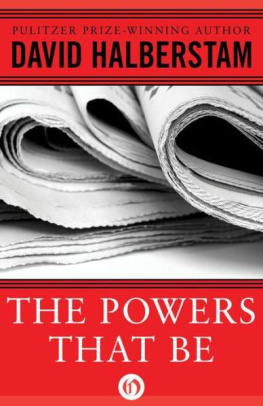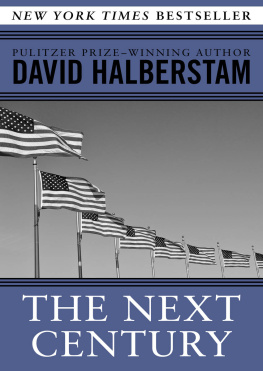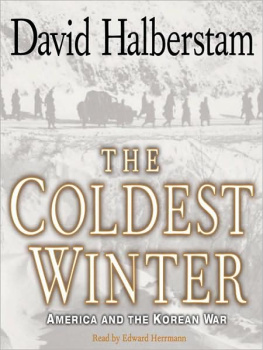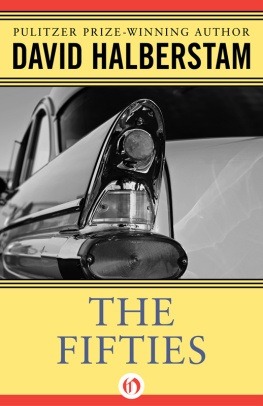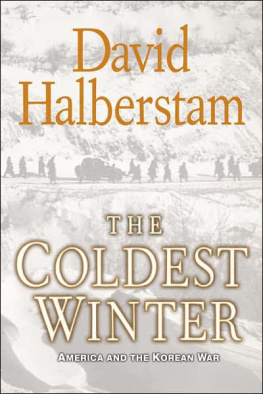The Fifties
David Halberstam

For Julia Sandness Halberstam
PREFACE
THE FIFTIES WERE CAPTURED in black and white, most often by still photographers; by contrast, the decade that followed was, more often than not, caught in living color on tape or film. Not surprisingly, in retrospect the pace of the fifties seemed slower, almost languid. Social ferment, however, was beginning just beneath this placid surface. It was during the fifties, for example, that the basic research in the development of the birth-control pill took place; but it was not until a decade later that this technological advance had a profound effect upon society. Then, apparently overnight, rather conservativeindeed cautioussexual practices were giving way to what commentators would speak of as the sexual revolution. It was in the fifties that the nation became wired for television, a new medium experimented with by various politicians and social groups. Ten years later television had begun to alter the political and social fabric of the country, with stunning consequences.
Three decades later, the fifties appear to be an orderly era, one with a minimum of social dissent. Photographs from the period tend to show people who dressed carefully: men in suits, ties, andwhen outdoorshats; the women with their hair in modified page-boys, pert and upbeat. Young people seemed, more than anything else, square and largely accepting of the given social covenants. At the beginning of the decade their music was still slow and saccharine, mirroring the generally bland popular taste. In the years following the traumatic experiences of the Depression and World War II, the American Dream was to exercise personal freedom not in social and political terms, but rather in economic ones. Eager to be part of the burgeoning middle class, young men and women opted for material well-being, particularly if it came with some form of guaranteed employment. For the young, eager veteran just out of college (which he had attended courtesy of the G.I. Bill), security meant finding a good white-collar job with a large, benevolent company, getting married, having children, and buying a house in the suburbs.
In that era of general good will and expanding affluence, few Americans doubted the essential goodness of their society. After all, it was reflected back at them not only by contemporary books and magazines, but even more powerfully and with even greater influence in the new family sitcoms on television. Thesein conjunction with their sponsors commercial goalssought to shape their audiences aspirations. However, most Americans needed little coaching in how they wanted to live. They were optimistic about the future. Young men who had spent three or four years fighting overseas were eager to get on with their lives; so, too, were the young women who had waited for them at home. The postWorld War II rush to have children would later be described as the baby boom. (Everything else in the United States seemed to be booming, so why not the production of children as well?) It was a good time to be young and get on with family and career: Prices and inflation remained relatively low; and nearly everyone with a decent job could afford to own a home. Even if the specter of Communism lurked on the horizonparticularly as both superpowers developed nuclear weaponsAmericans trusted their leaders to tell them the truth, to make sound decisions, and to keep them out of war.
For a while, the traditional system of authority held. The men (and not men and women) who presided in politics, business, and media had generally been born in the previous century. The advent of so strong a society, in which the nations wealth was shared by so many, represented a prosperity beyond their wildest dreams. During the course of the fifties, as younger people and segments of society who did not believe they had a fair share became empowered, pressure inevitably began to build against the entrenched political and social hierarchy. But one did not lightly challenge a system that seemed, on the whole, to be working so well. Some social critics, irritated by the generally quiescent attitude and the boundless appetite for consumerism, described a silent generation. Others were made uneasy by the degree of conformity around them, as if the middle-class living standard had been delivered in an obvious tradeoff for blind acceptance of the status quo. Nonetheless, the era was a much more interesting one than it appeared on the surface. Exciting new technologies were being developed that would soon enable a vast and surprisingly broad degree of dissidence, and many people were already beginning to question the purpose of their lives and whether that purpose had indeed become, almost involuntarily, too much about material things.
ONE
ONE
IN THE BEGINNING, THAT era was dominated by the shadow of a man no longer thereFranklin D. Roosevelt. He had died in 1945, but his impact on American politics was so profound that even the most powerful Republican leaders believed privately that their party might be permanently in the minority. Roosevelt had been cast forth in the midst of two transcending eventsthe Great Depression and World War Two. The first was responsible for a massive reordering of the American economy and society, thereby creating a huge, new base for the Democrats; the second permitted Roosevelt to emerge as an international leader in a time of great crisis and to prolong his presidency for two additional terms. During that time, the infrastructure of the Democratic party became ever more powerful and Roosevelt was able to extend his reach into the courts.
Roosevelt was the ultimate modern politician, the first great master of modern mass communications in a democracy. For millions of poorer Americans and for the new immigrants and their children, his ability to exploit radio and make it seem his personal vehicle had a particular resonance. To them, Roosevelt was not only President-for-life, he was their guide to the rites of American politics.
The effect of this on the Republican party, mired as it was in political attitudes that predated the Depression, World War Two, and the coming of radio, was devastating. In July 1949, some nine months after his own shocking defeat by Harry Truman (which seemed to promise the Roosevelt coalition would go on ad infinitum), Thomas E. Dewey met with Dwight Eisenhower, then the president of Columbia University, to begin the process of coercing Ike to run for the presidency in 1952 as a Republican. Eisenhowers notes of that meeting are unusually revealing of the Republican dilemma: All middle-class citizens of education have a common belief that the tendencies towards centralization and paternalism must be halted and reversed. No one who voices these opinions can be elected. He [Dewey] quotes efforts of Hoover, Landon, Willkie, Himself. Consequently we must look around for someone of great popularity and who has not frittered away his political assets by taking positive stands against national planning, etc, etc. Elect such a man to Presidency, after which [N.B.: italics Ikes] he must lead us back to safe channels and paths. In effect Dewey was saying that the solid citizens who could make the right decisions for the future of the country had, because of the New Deal, become a minority and that the nation had fallen into the clutches of dark and alien forces.
Not surprisingly, the Republican party was traumatized and bitterly divided. Certainly, the Democratic party was divided as well, between the liberal Northern urban coalition and the Southern conservative Jim Crow wing. But for all their differences, the Democrats had a certain glue: They won, and in victory there was patronage and power, a combination that transcended ideology. For the Republicans there was only the taste of ashes. They had been out of office since 1932. The shadow of the Depression still hung over them, and the Democrats were still running against Herbert Hoover, portraying the Republicans as the party of cold, uncaring bankers. Were the Republicans forever to be trapped by those events then twenty years in the past?


